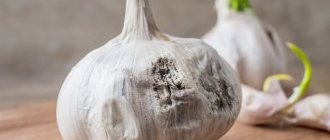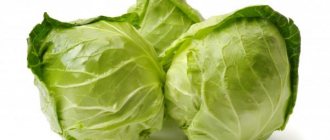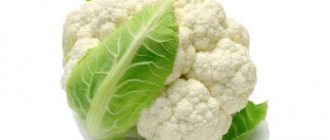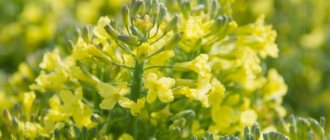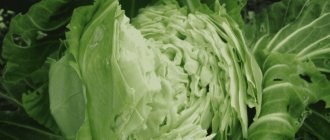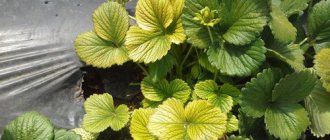What to do if cabbage rots on the vine
Rotting heads of cabbage occurs for the following reasons::
- non-compliance with plant care rules;
- unfavorable climatic conditions;
- diseases and pests.
Improper agricultural practices stimulate the development of root rot.
When planting cabbage on a plot, it is important to consider the following:
- Follow the planting pattern, maintaining 70–80 cm between heads of cabbage, and 90 cm between rows. This way, formed heads of cabbage will not shade each other and interfere with the development of neighbors.
- Plant the crop in a well-lit area, away from trees, bushes, fences and buildings.
- Avoid the formation of a dry crust on the ground. Loosen the soil after each watering or heavy rainfall so that the roots receive enough oxygen and the moisture does not stagnate.
- Do not plant cabbage in the same place from year to year (take a break for at least 4 years) or after plants with which it has common diseases (radishes, radishes).
- Use nitrogenous fertilizers only when planting. During the development of heads of cabbage, cabbage needs potassium fertilizing.
- Plant plants in soil with neutral or close to neutral acidity levels (pH 6.2–7.5).
- Before planting seeds for seedlings, disinfect them: for example, soak them in a weak solution of potassium permanganate.
- Provide plants with drip watering without flooding the outlets.
Note! Most often, it is a violation of agricultural technology that causes cabbage to rot.
When choosing varieties for planting, it is advisable to select those adapted for cultivation in a particular region. If the summer turns out to be rainy, and the soil does not have time to dry out after precipitation, make a canopy of film over the beds and remove the leaves in contact with the ground. Due to high humidity, rot quickly forms on them, which spreads throughout the plant.
Heat also indirectly contributes to rotting . Together with high humidity, it creates favorable conditions for the proliferation of pests that damage plants and transmit pathogens.
It is important to carry out timely prevention of the appearance of pests using drugs such as “Fitosporin”, “Knockdown”, “Iskra-M” or traditional methods:
- 1 tbsp. pour garlic and onion peels into a bucket of boiling water and leave for 24 hours, strain and use for spraying once a week;
- 1 tbsp. l. Dilute 9% vinegar in a bucket of water, apply once a week, spraying the solution over the plants;
- Once every 2 weeks, dust the cabbage with wood ash.
Next to cabbage, gardeners advise planting plants with an insect-repelling odor : marigolds, garlic, oregano.
Blackleg
A common crop disease that destroys hopes for a good harvest is black leg.
When cabbage is infected with blackleg, the symptoms are immediately visible : the lower stem darkens and rots. The disease occurs at all stages of crop development. The main reasons include excess nitrogen fertilizers, lack of oxygen and excessive watering.
Attention! Sudden changes in temperature can also provoke the development of blackleg. Therefore, it is important to transfer seedlings to open ground after spring frosts, and when growing in a greenhouse, monitor the temperature and avoid sudden drops.
There are several varieties of white cabbage that are resistant to this disease : Moskovskaya late 9, Belorusskaya 455, Amager 611. The drugs Fitosporin, Planriz, and Baktofit help fight black leg.
White rot
Due to prolonged rains, when the weather is humid and the heads of cabbage do not have time to dry out, cabbage is susceptible to this fungal disease . White mucus appears on the upper leaves, and in the voids between them a mycelium develops, gradually approaching the core of the vegetable.
Sometimes the disease develops from below, penetrating into the cabbage from the soil along the stem , especially if the size of the area does not allow changing the location of the cabbage from year to year. Therefore, before placing seedlings in open ground, water the soil generously with boiling water to destroy fungal spores.
Downy mildew
The causative agent of downy mildew waits in the wings in seeds and seedlings; it becomes active later, when the heads of cabbage begin to actively grow . The first signs are yellow spots of irregular shape on the upper leaves. They spread, gradually the leaf dries out and dies. Afterwards, a white powdery coating forms on the cabbage, under which the plant darkens and begins to rot.
To prevent downy mildew, gardeners disinfect seeds before planting and follow the layout of plants in the garden bed. Plant cabbage in soil cleared of plant residues and disinfected.
Vascular bacteriosis
Develops in regions with warm and humid climates . It appears as darkened vascular veins and black spots on the stem. Because of this, the plant does not receive nutrients from the soil and growth slows down. With vascular bacteriosis, heads of cabbage do not set.
Prevention of the disease includes thorough cleaning of the beds after previous plants and protecting the cabbage from heavy rainfall (for example, by creating a film canopy).
Pests are carriers of diseases
It has already been mentioned that insect pests are involved in the development of putrefactive processes on cabbage. Their role cannot be underestimated. Particularly dangerous are the larvae of butterflies - cutworms, whiteflies, cabbage moths, which not only eat the outer leaves, but also gnaw through holes in the heads of cabbage. Leaving behind open wounds, they facilitate the penetration of bacteria and fungi into the damaged area.
Cabbage bugs and aphids are no less dangerous. These insects pierce cabbage leaves and feed on their juice. Harmful microorganisms that cause diseases also enter the places where the piercing proboscis penetrates. In addition, by taking away nutrients from the plant, pests weaken its immunity.
Why does cabbage rot from the stalk?
A dangerous enemy of culture is mucous bacteriosis, or wet rot . The disease has 2 variants of its course, one of which is the penetration of bacteria through damage to the upper leaves. In this case, microorganisms reach the stalk and soften it, causing the head to fall off.
Several factors provoke the development of wet rot:
- the heads of cabbage were damaged during care;
- the soil is swampy or oversaturated with moisture due to heavy rainfall;
- due to frequent rains, the leaves and head of cabbage are constantly wet;
- plantings are attacked by caterpillars that eat the upper leaves.
Most often, mucous bacteriosis affects the plant in the second stage of the growing season .
Signs of defeat
The initial stage of the disease is very difficult to notice. Infected cabbage growing in a garden bed can have two options for the development of the disease:
- Covering leaves rot. The outer leaves darken, become covered with mucus and emit a rotten smell. Slowly and surely, bacteriosis takes over the entire head of cabbage, which leads to the inevitable death of the plant.
- The spread of infection begins from the stalk. In this case, pathogenic microorganisms infect the stalk through the soil or insects. It changes color to dark and becomes softer. The disease progresses quickly, the inner leaves become dirty cream in color, soften and eventually the head of cabbage falls off.
During cabbage storage, rot goes unnoticed for a long time. The inner part of the stalk gradually decomposes and turns into a slimy mass with a putrefactive odor. It is possible to detect bacteriosis when most of the head of cabbage is affected.
What to do if a head of cabbage rots in the garden
Having noticed signs of rotting cabbage, gardeners do not always know how to save the crop. The algorithm of actions depends on where exactly the rot appears .
In the middle
In this case, it is impossible to save the affected heads of cabbage; the rot will continue to spread . Therefore, they are dug up and burned outside the site, and healthy plants and soil are disinfected. The soil is watered with a 3% solution of copper sulfate. Product consumption - 2 l/m². The drug "Previkur" is also suitable.
Attention! Healthy cabbage is sprayed with Fitosporin.
In case of mucous bacteriosis, diseased plants are dug up and destroyed , carefully removing plant debris from the beds. The soil is disinfected with a 0.5% solution of potassium permanganate or 3% copper sulfate.
Upper leaves
If putrefactive lesions are noticed on the upper leaves, the plants can still be saved . To do this, diseased cabbage is cut off, the covering leaves are removed, and the heads of cabbage are sent for culinary processing.
If the crop is not yet ripe, the diseased plants are left, cutting off the affected leaves almost at the base. It is important to remove all rotting surface. After this, the cabbage is treated with “Fitosporin”, and the soil under it with “Previkur”.
Preventive measures
Prevention is a universal method of protecting health, therefore, first of all, every gardener should take care of preventive measures:
- you need to monitor the temperature of the room in which the vegetable is located before planting in the ground: it should not be lower than +15°C;
- Dense dense planting should be avoided: the distance between the beds should be at least 1.5 m;
- care should be taken to regularly expose the vegetable to sunlight;
- proper watering;
- changing beds, i.e. practice crop rotation;
- weeding.
Sources:
https://fermhelp.ru/pochemu-gniet-kapusta-na-kornyu/ https://gryadki.com/kapusta/pochemu-gniet-na-kornyu-9643/ https://fermer.blog/bok/ogorod/ kapusta/vyraschivanie-kapusty/problemy-kapusty/3556-pochemu-kapusta-gniet-na-kornyu.html
Results
Despite the excellent shelf life of late- and mid-ripening cabbage, the vegetable is also susceptible to diseases during long-term storage. The most common diseases of white cabbage are gray and white rot, necrosis and bacteriosis. Almost each of them causes infection of the entire set of cabbage heads, as it spreads easily.
But there are a few simple tips that will help preserve cabbage longer:
- Harvest correctly and pre-dry the harvested heads.
- Place cabbage properly in the cellar, ensuring sufficient air circulation between the forks.
- Pre-wash the cellar or basement, treat it with an antiseptic and maintain the required level of humidity and temperature.
If you follow these simple tips, cabbage will last until spring and will delight you with its excellent taste at any time of the year!
Causes of the disease
Pectobacterium carotovorum subsp. carotovorum (Jones) Waldee is a bacterium that is the causative agent of bacteriosis. The pathogenic microorganism is widespread everywhere. It is active and affects crops most often against the background of reduced plant immunity. There are several reasons that are the trigger for slowing down the protective work of the immune system.
Imbalance of nutrients in the soil
Excessive nitrogen content in the soil leads to the growth of huge leaves. In this case, the structure of the leaf plates becomes very loose and porous. Through such a surface, microbes easily penetrate plant cells.
A lack of calcium further aggravates the situation. Plant growth stops, leaves become thin and fragile. Even a slight wind easily tears and damages cabbage. Through wounds, the infection quickly affects the culture.
To avoid an imbalance of substances in the soil, the soil should be properly prepared for planting. Adding fresh manure or rotted manure in excess will cause the cabbage to become “fatty.” Feeding cabbage can be carried out strictly in accordance with the recommendations of agronomists. In this case, it is better to stick to the golden mean, not to overfeed the plants and not make them suffer from a lack of substances. So, as cabbage grows, it no longer requires nitrogen fertilizers, but phosphorus-potassium compounds will be very useful.
Wood ash can be used as a phosphorus-potassium fertilizer. In addition to potassium and phosphorus, ash contains a large amount of micro- and macroelements.
Weather
The disease develops especially actively in damp and hot weather. Air temperatures above 25 °C and high humidity are favorable conditions for the rapid proliferation of bacteria. During long and prolonged rains, a water film forms on the surface of cabbage leaves. Microbes accumulate in stagnant water and penetrate the plant tissue.
